Search Thermo Fisher Scientific
Carbazole, 95%, Thermo Scientific Chemicals



Carbazole, 95%, Thermo Scientific Chemicals
Chemical Identifiers
Specifications
Description
This Thermo Scientific Chemicals brand product was originally part of the Alfa Aesar product portfolio. Some documentation and label information may refer to the legacy brand. The original Alfa Aesar product / item code or SKU reference has not changed as a part of the brand transition to Thermo Scientific Chemicals.
Carbazole and its derivatives are widely used as an intermediate in synthesis of pharmaceuticals, agrochemicals, dyes, pigments and other organic compounds. carbazole is also used in luminescence chemistry as a photosensitizing and additional charge transport material. Carbazole structure is a motif in pharmaceuticals such as carvedilol used to treat high blood pressure and to prevent cardiac arrhythmias and angina.
Solubility
It is insoluble in water.
Notes
Stable under ordinary conditions. Store in cool place. Keep container tightly closed in a dry and well-ventilated place.
Figures
Documents & Downloads
Certificates
Frequently asked questions (FAQs)
Citations & References
Safety and Handling
Classification of the substance or mixture
CLP classification - Regulation(EC) No 1272/2008
Label Elements
Signal Word
Warning
Hazard Statements
H315 - Causes skin irritation
H319 - Causes serious eye irritation
H335 - May cause respiratory irritation
H351 - Suspected of causing cancer
H410 - Very toxic to aquatic life with long lasting effects
Precautionary Statements
P261 - Avoid breathing dust/fume/gas/mist/vapors/spray
P273 - Avoid release to the environment
P305 + P351 + P338 - IF IN EYES: Rinse cautiously with water for several minutes. Remove contact lenses, if present and easy to do. Continue rinsing
P280 - Wear protective gloves/protective clothing/eye protection/face protection
P332 + P313 - If skin irritation occurs: Get medical advice/attention
P337 + P313 - If eye irritation persists: Get medical advice/attention